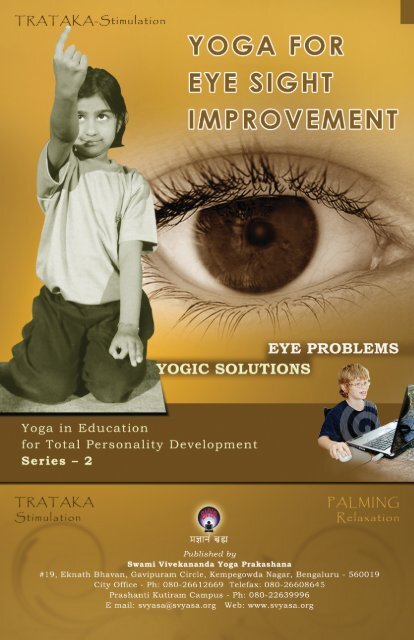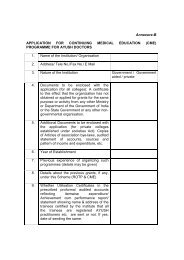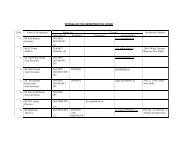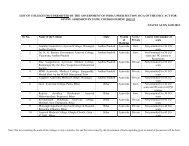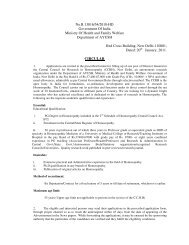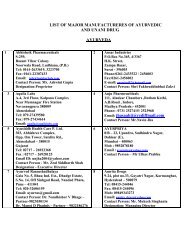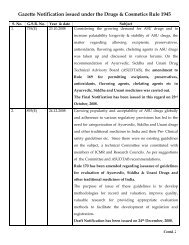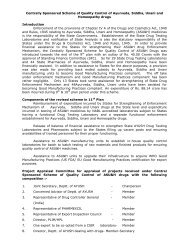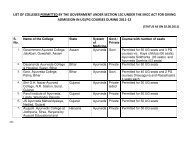Yoga for Eye Sight Improvement
Yoga for Eye Sight Improvement
Yoga for Eye Sight Improvement
- No tags were found...
Create successful ePaper yourself
Turn your PDF publications into a flip-book with our unique Google optimized e-Paper software.
8 | <strong>Yoga</strong> <strong>for</strong> <strong>Eye</strong> <strong>Sight</strong> <strong>Improvement</strong>When we continued children with -5, -6, -7 children were ableto normalise their eyesight. Then we started taking up this.Initially we have short theory and then we go <strong>for</strong> the practiceand what is the whole basis <strong>for</strong> the eyesight improvement thatwe are talking? Many people think that the accommodationpower of the lens is going to change. No. It is <strong>Eye</strong> Ball Curvature.In short sight the image is falling too far in front of theFovea. But why is that distortion taking place in the eye ball?This is because of the differential pull of the rectie muscles ofthe eye ball.So when we do yoga inwhich we handle the eyeexcercises to see that themuscles co-ordinate socohesively that the eyeball starts becoming normal.How do we know itis going to become normal? One of our Opthalimic specialistDr. Upadhyay in England, measured the eye ball curvatureand after 15 days, after one month of yogic practices the eyeball curvature started getting normal. Such results prove thatyoga brings in normalisation and it is these techniques thatwe have used. Trataka is the specialised practice that yogaprescribes. It is one of the six kriyas. Kriyas are essentiallymeant <strong>for</strong> cleansing and to strengthen the nerves which connectthe eyes to the brain which handles the different musclesand calming down of the mind, silencing of the mind, slowingdown of the breath, does wonders. There<strong>for</strong>e in this modulewe are going to use some Asanas, special breathing practicesand mainly the Trataka and the meditation which help thepeople develop their eyesight.<strong>Yoga</strong> in Education <strong>for</strong> Total Personality Development SERIES - 2
10 | <strong>Yoga</strong> <strong>for</strong> <strong>Eye</strong> <strong>Sight</strong> <strong>Improvement</strong>camera. Our eyealthough is comparableto a camera, isnot having a shapeof a camera. It isa beautiful globule.It is a beautifulspherical ballwhich has got allthe functions of acamera. For example,in this picture,you can see the iris with its aperture and the diaphragm. Lightpasses through the aperture which is covered by a very transparentglossy convex sheet called the Cornea. This is highlysensitive structure of the eye. You would have experienced evenbe<strong>for</strong>e any dust particle sits on the eye, you would have blinked.So this Cornea is a highly sensitive but extremely transparentconvexlayer whichcovers the frontof the eye. Asthe light passesthrough theCornea and thePupil, it passesthrough theconvex lens ofthe eye whichfocuses the<strong>Yoga</strong> in Education <strong>for</strong> Total Personality Development SERIES - 2
<strong>Yoga</strong> <strong>for</strong> <strong>Eye</strong> <strong>Sight</strong> <strong>Improvement</strong> | 11light rays on to the back of the eye ball. These light rays thatpass through the Cornea, will get refracted there, then they getfinely adjusted at the convex lens and the light passes throughto the back of the eye where the photo sensitive layer of the eyeexists called the Retina. Just like in a convex lens which youwould have seen in your physics experiments in your schooldays, there is a focal point where very clear image of the objectin front is focused through the convex lens. Similarly thenatural eye has a capacity to adjust the shape of the convexlens so that the light rays fall exactly at the focal point so thatthe Retina is getting the sharp image of the object that wesee. This Retina has got photo sensitive sensors, photo sensors.What are these photo sensors? They are called Rodsand Cones which can sense the light rays. They are calledRods and Cones which convert the light energy through chemicalenergy into the electrical energy and pass it on throughthe relay nerves to our optic nerves. So all these fibers frommillions of these Rods and Cones carry this in<strong>for</strong>mation to oureye ball where the Retina carries the image and converts itfrom light energy to electrical energy. The in<strong>for</strong>mation is carriedon to our brain through the optic nerves. The light raysare now transferred as electrical activity to the actual cortexof the brain called the Occipital Cortex. This Occipital cortexis there behind our head, the last portion of the big chunk ofthe brain. The Occipital Cortex starts interpreting doing lotsof interconnections, interpretations and intermingling of in<strong>for</strong>mationchecking with past experience, post experience, lots ofnerve connections, do lots of computerization and finally theimage is transferred on to our mind. It is the mind that doesthe perception and finds the meaning of the image that has<strong>Yoga</strong> in Education <strong>for</strong> Total Personality Development SERIES - 2
12 | <strong>Yoga</strong> <strong>for</strong> <strong>Eye</strong> <strong>Sight</strong> <strong>Improvement</strong>been seen.Say <strong>for</strong> example, you are seeinga beautiful tree. All thecolour clear images are to betransferred on to the specificspot in the Retina. If the treeis not in front of your eyes, if itis to the side, then you cannotget very clear picture. Supposeyour friend walks intothe room, you suddenly turnyour eye balls to see who it is. Although you have big area thatis covered by the big area of the Retina, the image has to fallon a specific point in the Retina called the Fovea or the Maculaof the Retina where there are large number of Rods and Cones.To do that nature has provided us with an ability to move theeye ball in various directions with good number of muscles attachedto the eye ball. So wherever we want any movement inthe body, if we want to move the hand also, we need the musclesthere. Just like a muscle moves the hand up, the externalmuscles of the eye ball moves the eye ball in different directions.So we want to move the eye ball upwards, downwards,to the left, to the right. There<strong>for</strong>e to move the eye ball we havevery thin strip of muscles which are attached to the eye ball allaround and these muscles when they contract, move the eyeball. So if you want to move the eye ball upward, you have aset of muscles and the upper portion called the Superior rectusWhich pulls the eye ball in the upward direction. Pullingthe eye ball in the downward direction is possible by moving<strong>Yoga</strong> in Education <strong>for</strong> Total Personality Development SERIES - 2
<strong>Yoga</strong> <strong>for</strong> <strong>Eye</strong> <strong>Sight</strong> <strong>Improvement</strong> | 13the lower set of themuscles to right andmoving the eye ballto the left is possiblethrough lateralset of muscles. Variousrotatory movementsare possiblethrough a sling of theoblique muscles. Onthe whole, eye ballhas got six musclesthat have to work ina highly coordinatedway. When object onto your right has tobe seen, you want to move the left ball to the right and theright eye ball to the right. So coordination is brought aboutby in<strong>for</strong>mation that is carried from the brain along the nerves.These nerves gives the correct in<strong>for</strong>mation to the correct setof coordinating muscles. This is how we are able to get a verysharp image focused on to the Fovea of the retina. Here theclear image is interpreted or converted into electrical activity.There is also another very important activity that goeson in the eye with all the work that wedo. Say when you are looking at a verydistant object all the eye muscles arerelaxed. As soon as you want to reachor look at a T.V. or a computer screen,there is a lot of adjustment that eye has<strong>Yoga</strong> in Education <strong>for</strong> Total Personality Development SERIES - 2
14 | <strong>Yoga</strong> <strong>for</strong> <strong>Eye</strong> <strong>Sight</strong> <strong>Improvement</strong>to do. Shrinkingor constructionof the pupil,thickening of thelens and drawingin of the eyeballs all thesethree put together is called the accommodation reflex. Thisgoes on very naturally. So try and understand how complex,how beautifully the nature has provided this mechanism todo whatever we want and to get a beautiful picture, the colourand the beauty of the world and appreciate it.<strong>Yoga</strong> in Education <strong>for</strong> Total Personality Development SERIES - 2
<strong>Yoga</strong> <strong>for</strong> <strong>Eye</strong> <strong>Sight</strong> <strong>Improvement</strong> | 15PROBLEMS OF EYEWHERE YOGA CAN HELPUnderstanding the Anatomy, Physiology and the problems ofthe eye according to understood by Modern Medical Sciencewill help us to understand how yoga can help us in improvingour eyesight. So let us see what are all the problems of the eyewhere <strong>Yoga</strong> can be of great help. These are all the conditionswhere <strong>Yoga</strong> has been tried and large number of people havebeen benefited by doing <strong>Yoga</strong> <strong>for</strong> these problems. One of thecommonest problems faced today with the modern life style isthe computer related eye problems and eye strain. <strong>Eye</strong> strainbecause of continuous near work <strong>for</strong> long hours, either readinga small printed book or computer work or watching a TVor watching a CD, playing computer games all these lead tocontinuous near work. Present day life style has lead us to doso much of near work that almost we have <strong>for</strong>gotten how to doa relaxed distant vision. For example, you see some computerprofessionals when they are walking on the street they arelooking and seriously thinking of something and looking as iftheir eyes are fixed <strong>for</strong> near vision. We have <strong>for</strong>gotten to openour eyes, look at the distant objects, enjoy the trees and birds,flowers by looking at the sky, looking at the nice clouds andthe beautiful stars and moon because of so much of habit ofnear work. We have understood how near work has a need <strong>for</strong>the eyes to do intense activity. Near work means accommoda-<strong>Yoga</strong> in Education <strong>for</strong> Total Personality Development SERIES - 2
16 | <strong>Yoga</strong> <strong>for</strong> <strong>Eye</strong> <strong>Sight</strong> <strong>Improvement</strong>tion. Near work means constriction of the pupulary muscles.Tightening of the muscles of the lens to thicken the lens sothat we would focus in the right direction and moving the eyeball in the inner direction. So that the inner muscles of theeye all the time are constricted. So there will be lot of work onthin muscles of the eye inside the eye ball. In modern life styleone is engaged in near work continuously <strong>for</strong> eight hours, tenhours, twelve hours sometimes, 18 hours. Even after the activework is over in 8 hours in a day, one comes back and watchesTV which may go on <strong>for</strong> another 2 or 3 hours. So continuouslyif the muscles are contracted, which we are not awareof, the muscles say, sorry I cannot do any more work, I wantto relax. This is exactly what is the experience of eye strain. Itis something like you are going on keeping your hand musclesi.e. bisect muscles which are visible, tight <strong>for</strong> 18 hours in aday. What will happen? Your muscles will say sorry, I amtired, I am exhausted, please relax off. I am feeling pain. Thisis the cause of eye pain and eye strain and this goes on to pourdown lot of tears in the eyes which may further go on to manyother more deeper structural disturbances in the eyes. So eyestrain, eye pain are all very common problems and are consideredas computer related eye problems. When the eye strain isgoing on and on like this, muscles are tight. Not only musclesare held tight, it leads to poor immune system in the eyes also.So repeated stye is commonly associated with eye strain. Youknow what is a stie? At the margin of the upper or lower eyelid there will be a small swelling, a small boil, Very painful.It becomes red and swollen. Then a pus comes out after 4 or5 days. Repeated styes is another very common associationof eye strain. This is all about only the local over work of the<strong>Yoga</strong> in Education <strong>for</strong> Total Personality Development SERIES - 2
<strong>Yoga</strong> <strong>for</strong> <strong>Eye</strong> <strong>Sight</strong> <strong>Improvement</strong> | 17eye muscles and the eye balls. But imagine eyes are not onlyan independent camera which is sitting outside of you. It isplaced inside our system, so it is reflecting the activity of theentire system. If the mind is over active, over strained, overagitated, stimulated and excited then that can be reflected inthe tightness of the neck and the shoulders can also reflectas tightness of the external and internal eye muscles. Thiswill add on general worry, general tension, general anxiety,general stress at the mind level plus the local work of the eye,both add on to the tightening of the muscles, exertion of themuscles, weakening of the muscles over a long period of time.This is the cause of many of the further complications that wesee that are associated with early aging changes or problemsthat are related to the eye. Errors of refraction is another verycommon condition where we use <strong>Yoga</strong> <strong>for</strong> helping people toreduce therefractive error of the eyes.<strong>Yoga</strong> in Education <strong>for</strong> Total Personality Development SERIES - 2
18 | <strong>Yoga</strong> <strong>for</strong> <strong>Eye</strong> <strong>Sight</strong> <strong>Improvement</strong>YOGA FOR REFRACTIVE ERRORSLooking at the problems of the eye, where <strong>Yoga</strong> has beenfound to be effectively used, let us try to understand what arethe errors of Refraction, Myopia or Short <strong>Sight</strong>, Hyperopia orLong <strong>Sight</strong>, Astigmatism or Irregular Curvature, Pressbíopiathe ageing changes where people need to use reading glassesare all problems of Refraction. This is due to the inability ordifficulty of focusing of the image that has to fall right on thesharp point called the Fovea or Macula in the Retina. The shortsight or Myopia is a condition where the eye ball of the personis too long and there<strong>for</strong>e the, the sharp image which has to beat the focal point of the lens is falling too far in front of the Fovea.The eye ball, has become too deep now. Thus the imageis falling too far in front. By the time the image reaches theFovea, it is blurred. The person moves the object very near.Thus the image gets pushed further back. He will be able tosee better. Thisis called Short<strong>Sight</strong>.What is Long<strong>Sight</strong>? In longsight it is the reverse.The imageis falling too far<strong>Yoga</strong> in Education <strong>for</strong> Total Personality Development SERIES - 2
<strong>Yoga</strong> <strong>for</strong> <strong>Eye</strong> <strong>Sight</strong> <strong>Improvement</strong> | 19behind the Retina. The eyeball shape had to be long.After all the possible adjustmentsof the lens, good andsharp image which is at thefocal point is falling too farbehind. There<strong>for</strong>e the imagebecomes blurred. What doesthe person with long sightdo? He keeps the picture toofar behind. The image comesfurther in. It is called as Long <strong>Sight</strong>. These two conditions arevery common and Astigmatism usually goes with Myopia orlong sight. In this, there is an irregularity of the surface of theCornea. If the Cornea is smooth in one plain and it is irregularin another plane. The image is not sharp and there<strong>for</strong>e onehas to make corrections which has to be done by using differenttypes of lenses. In addition to this, hereditary tendencywhich makes the eye ball remain in a particular shape, justlike a long nose or a tall personality the shape of the eye ballalso is a hereditary tendency which leads to short sight or longsight.But there is another factor which is very common and that iswhat we are seeing in the present day life style that is the effectof strain on the eyes. Too much strain on the eyes can makethe errors of Refraction become worst. So if you already havea hereditary tendency, the excess eye strain, excessive nearwork plus the mental tension which cause a general stress andstrain aggravates the errors of Refraction and there<strong>for</strong>e by the<strong>Yoga</strong> in Education <strong>for</strong> Total Personality Development SERIES - 2
20 | <strong>Yoga</strong> <strong>for</strong> <strong>Eye</strong> <strong>Sight</strong> <strong>Improvement</strong>age of 20, 30yrs the power goes on increasing. So far example,a person starts using glass <strong>for</strong> the first time in his 20, 25yrsthat means it is purely due to eye strain. If the person startsneeding a glass right from the age of 5 or 6yrs that meansthere is a hereditary tendency. Hereditarily longish or thinnisheye ball but it gets aggravated as the age advances. Sothere are three stages. When they are 5, 6, 7 Yrs old, they startusing glasses. Then in adolescence it gets aggravated again asthe eye work increases in their early 20s, It further increases.So these are the areas where <strong>Yoga</strong> can be of great help. Infact the very first book Better <strong>Eye</strong>sight without Glasses waswritten by a sufferer who was having short sight. He was usingquite a thick glasses, may be of 3 or 4 and as he was growing,doctors used to tell him look, you are getting this power and itis going to get worse, but you use the glass very regularly thepower will not get worse. There<strong>for</strong>e this sincere youngster Mr.Bales started using the glass is very regularly but the powerwent on increasing. Then he started searching. Although Iam correcting the error which is basically correcting the shapeof my eye ball, why should it go on increasing? There<strong>for</strong>e hestarted doing lot of reading. When he read the whole thingand when he experienced the same thing, he realized that witheye strain, the error goes on increasing. More near work morestrain. Less sleep, more tension, mental worries, all these (eitherlocal or general as we understood earlier ) can aggravatethe errors of refraction. There<strong>for</strong>e what did he do? He said,OK, over work of the eye is the problem which is making mypower get worst, then what is the answer? Just wearing theglasses cannot be an answer. There<strong>for</strong>e what he said was OK,let me give lot of rest <strong>for</strong> my eyes. Does that mean he shouldnot read at all? Does that mean he should not do computerwork? No. He said OK several times in a day I will blink and<strong>Yoga</strong> in Education <strong>for</strong> Total Personality Development SERIES - 2
22 | <strong>Yoga</strong> <strong>for</strong> <strong>Eye</strong> <strong>Sight</strong> <strong>Improvement</strong>EYE PROBLEMS – YOGIC SOLUTIONSIn earlier Chapter, we focused on <strong>Yoga</strong> <strong>for</strong> Refractive Errors.We devote this Chapter <strong>for</strong> other eye problems where <strong>Yoga</strong> canbe of great help. Glaucoma is a very common condition wherepeople may lose their eyes if not detected. This is one conditionwhere there is no complaint, until the person starts feeling blurringof the vision. What is Glaucoma? Glaucoma is increasedpressure of fluid in the anterior chamber of the eye that is infront of the lens. To maintain the shape of the eye ball, naturehas provided fluid in the anterior chamber and poateriorchamber. The anterior chamber contains a fluid called aqueoushumor and this vitreous humor or vitreous humor fluidis to be continuously kept in circulation. The aqueous humordrains through apassage at the angleof celiary bodywhere there is amesh like materialand is drainedout through theblood vessels.If this gets disturbedthe pressureinside thisanteriorchamber<strong>Yoga</strong> in Education <strong>for</strong> Total Personality Development SERIES - 2
<strong>Yoga</strong> <strong>for</strong> <strong>Eye</strong> <strong>Sight</strong> <strong>Improvement</strong> | 23goes on increasing. This reflects on the back chamber alsoand that can press on the Retina and create blurring of thevision and loss of vision. There are two types of Glaucoma.Open Angle Glaucoma and Closed Angle Glaucoma. ClosedAngle Glaucoma is a medical emergency. So immediate surgeryhas to be done. It is a rare condition. But the commonone which we see as Chronic long standing age related problemis usually seen in people with Diabetes, Hypertension, asthe age advances and if there is a strong family tendency <strong>for</strong>Glaucoma.Can <strong>Yoga</strong> help these peoplewith Glaucoma? Yes. Tratakais extremely useful in openingup this angle. To open up thisangle and allow the fluid to flowbetter, we need to pull the diaphragm,the iris and shrink thepupil. When we do the Trataka with Jyoti Trataka particularlyor Bhroomadhya Trataka or Nasagra Trataka, then this pupilconstricts. The constriction of pupil is one of the usual treatmentthat is used in the <strong>for</strong>m of <strong>Eye</strong> Drops in the treatment ofGlaucoma, so that when the pupil is pulled in, the diaphragmis pushed. There<strong>for</strong>e the angle on the outer side opens upand there<strong>for</strong>e the pressure inside can reduce. So Jyoti Trataka,lot of rest and also the over all Integrated Approach of<strong>Yoga</strong> Therapy will help to see that it helps the ageing processgets delayed or the High Blood Pressure gets reduced, Diabetescomes under control. The root cause of all these problemscan be handled through <strong>Yoga</strong> Therapy. When we use the con-<strong>Yoga</strong> in Education <strong>for</strong> Total Personality Development SERIES - 2
24 | <strong>Yoga</strong> <strong>for</strong> <strong>Eye</strong> <strong>Sight</strong> <strong>Improvement</strong>cept of Integrated Approach of <strong>Yoga</strong> Therapy where we understandthat eye is not an isolated organ in the whole system.Our body, mind are all one single unit. When the mind is goingthrough a very stressful period, the eye problems can bea major issue. There<strong>for</strong>e when we do <strong>Yoga</strong> Therapy, it is notenough if you just do local eye practice. There<strong>for</strong>e let us seehow <strong>Yoga</strong> practices help.One is basically the relaxation, Deep relaxation of the eyeswhich is achieved through deep relaxation at the mind bodycompelx, Shavasana relaxation techniques, breathing techniquesetc., which is also very important. When we teach YogicPractices to our children with the short sight, we includePranayama, Shavasana, QRT, DRT etc., which we are seeingin the practices. In addition to that, we also use general staminabuilding practices in which the eye also becomes a partof the whole practice which is the general relaxation, generalstamina building. But locally, with the eye we have understoodwhat is very important is lots and lots of local relaxation to theinternal eye muscles as well as external eye muscles. There<strong>for</strong>edoing palming, winking, blinking etc.; is very importantcomponent. During Trataka practice, the focusing on the lampor the finger tip etc. has to be done intensely, sharp focusingwithout blinking the eyes even the tears may come out of theeyes. You should hold the focusing or dharana as it is saidin technical language <strong>for</strong> quite a duration of time allowing thetears to come out. How is that going to help the eyes? If theeye is already over strained; how again overstraining the eyestill the tears come while doing Trataka be helpful? In Tratakawe develop voluntary, mastery over the involuntary reflexes<strong>Yoga</strong> in Education <strong>for</strong> Total Personality Development SERIES - 2
<strong>Yoga</strong> <strong>for</strong> <strong>Eye</strong> <strong>Sight</strong> <strong>Improvement</strong> | 25of the eye by persistant stimulation followed by deep rest. Wewant to focus, we want to intensely strain the eye but consciously,wantingly, voluntarily and after that give very deeprest. A stimulation, activation, focusing and intense rest <strong>for</strong>the muscles. For example say if you want to relax the fingers,what I would say? Hold the hand on the other hand Relaxyour fingers, relax your fingers. To some extent the tightnessof the fingers will reduce. But if I ask you to make a fist,tighten your fingers and then relax continue that process ofrelaxation consciously into deeper and deeper and deeper rest,then the hands can relax much deeper. This is the principleof stimulation followed by deeper and deeper and deeper restabout which you will understand as you practice which makesthe eye muscles stronger. <strong>Eye</strong> muscle stamina improves. Thesharpening of the ability of the eye as well as to hold on to nearwork <strong>for</strong> longer duration can increase. Stamina building effectcan come which in Sanskrit is called titeeksha.<strong>Yoga</strong> in Education <strong>for</strong> Total Personality Development SERIES - 2
26 | <strong>Yoga</strong> <strong>for</strong> <strong>Eye</strong> <strong>Sight</strong> <strong>Improvement</strong>EYESIGHT IMPROVEMENT ANDTHE TOTAL INSIGHTWhen you talk about eyesight, it is not merely the improvementin the functioning of this eye, but also it should develop aeyesight, a sight into the real wisdom tradition of our country.What is that insight? That insight is to recognize our Self, thatinsight is to understand that we have that infinite AnandamayaKosa as our causal state. It is from that Anandamaya Kosathat we all are born, coming through the Vijnanamaya Kosa,Manomaya Kosa, Pranamaya Kosa and the Annamaya Kosa.There<strong>for</strong>e when we are talking about the eyesight improvement,we work in tune with this total insight of the wisdom base. Weknow that Anandamaya Kosa is a state of complete silence.Chitta vritti nirodhaha has happened completely. Manahprashamanahashappened almostto the core. Themind is in thestate of Avyaktaand in this statewe have almostinfinite bliss, infiniteknowledge,infinite power.Coming out of the<strong>Yoga</strong> in Education <strong>for</strong> Total Personality Development SERIES - 2
<strong>Yoga</strong> <strong>for</strong> <strong>Eye</strong> <strong>Sight</strong> <strong>Improvement</strong> | 27Anandamaya Kosa to Vijnanamaya Kosa, Manomaya Kosa,Pranamaya Kosa and Annamaya Kosa brings about the constriction.We are becoming smaller and smaller and constrictourselves to the physical body and the eyes. We start gettingthe crunch of that Duryodhana in the Manomaya Kosa, the Aadhiwhich percolates down and Causes imbalance even in theeyes. The stress and the imbalance which percolate from Aadhii.e. Manomaya Kosa comes down to the Pranamaya Kosabringing imbalances in the prana leading to haphazardness ofthe breath, jerky breath and imbalance in breathing which inturn can cause different physical ailments and even eyesightproblems are no exception. We use the techniques to deal withthe eyes at the physical level. At the same time we bring in thewisdom base to give a total personality. As we improve our eyesight we will develop that insight to move towards that highestheights of <strong>Yoga</strong>. To move from animal level to become normal,great, super and divine human beings. That is the objective ofthis eyesight improvement program as a part of the personalitydevelopment program. The techniques that we use here,on one side makes eyes focus, bringing great stimulation andbrings relaxation through the palming. A Trataka, a palming,a Trataka, a palming.That <strong>for</strong>ms the basis <strong>for</strong> the eyesight improvementprogram. We have the preparatory practices, thenJatru Trataka in which Oordwamukha, Adhomukha Tratka,Nasagra Trataka, Bhroomadhya Trataka, Vama jatru trataka,Dakshnina jatru trataka are there. All these things will harnessthe power of the eye muscles to improve our eyes. Butthen <strong>for</strong> correction we use the Jyoti Trataka. Jyoti Tratakais to focus the eyes on the flame. The flame can be of an oilwick or it can be of a candle and sit at five feet distance keep-<strong>Yoga</strong> in Education <strong>for</strong> Total Personality Development SERIES - 2
28 | <strong>Yoga</strong> <strong>for</strong> <strong>Eye</strong> <strong>Sight</strong> <strong>Improvement</strong>ing the jyoti at the level of the eyes. You start staring at it, nowinking, no blinking and look deep into the flame. Invariablythe people with high eye power, short sight they start seeingmultiple flames.I remember one of the persons who had -5, after the first sessionhe came and told, Sir I am seeing five different flames. Sowhat is to be done? Which flame I should concentrate? He wasasking. Another person was more bewildering he had -12, hesaid I cannot see that flame vividly. It is all like a blob andwhen he started improving, he started seeing 12 flames, 10flames, 8 flames, 6 flames. And the first step is to bring themtogether by so adjusting your eyes so squinting so turning youreyes together to bring the multiple flames into a single flame.That will start reducing your eye power. Jyoti Trataka therebystarts correcting. Once you are able to bring the whole thinginto a single flame, then you start looking deep into that flameand observe the intensification of the flame. At the bottom youhave the wick then at the tip of the wick you have a red firedot and then comes a flame which is almost darkish in colour.Then the big flame will have the highest intensity here and itcomes in to the tip. The whole flame structure you are able tosee clearly as you start improving and looking at this. As youreye power enhancement takes place, then you are able to seethat <strong>for</strong> 30 seconds , one minute, two minutes. Then whenyou grow further one minute, Jyoti Trataka staring at it oneminute first stage palming, two minutes second stage palmingin which you press and release, press and release, stimulaterelax,stimulate-relax in which you give deep rest to the eyesand in the third you look at <strong>for</strong> 3 mins continuously staring at<strong>Yoga</strong> in Education <strong>for</strong> Total Personality Development SERIES - 2
<strong>Yoga</strong> <strong>for</strong> <strong>Eye</strong> <strong>Sight</strong> <strong>Improvement</strong> | 29it without winking and blinking and get all the details, the vividdetails of not only the flame but the wick and the blue flameand the things and aura around the flame and close your eyesand do the third stage of palming in which you not only pressbut use the Bhramari to develop a resonance and harmonizethe entire face and the eyes. As you start relaxing the eyesyour mind relaxes, breathing slows down, prana slows downas the mind starts fatheming the peace and the silence and theserenity. The stress is vanished. The imbalances come downand the reduced imbalance will start bringing down the imbalance<strong>for</strong> the eyes and that calming of the mind, that silencingof the mind is the balance factor <strong>for</strong> the stress and there by,the mind starts getting cleansed and as you go deeper anddeeper, you will be able to grow higher removing all the imbalance.The muck and the dirt inside in our deep sub-consciousand you will overcome stresses and grow to great heights. Finallygetting glimpses of that Anandamaya Kosa, getting insightinto your causal state of Anandamaya Kosa is the onethat brings all the bliss. There<strong>for</strong>e not only the eyes overcomedefects of short sight, long sight, astigmatism, squint initialstages of cataract but also it brings insight to go to our state ofAnandamaya Kosa and to manifest that Anandamaya Kosa inour day to day life. <strong>Eye</strong>s become beautiful, become sensitive,become sharp on one side and on the other side you will findyour mind becoming calm, silent, thus giving dual advantagesof this program of <strong>Eye</strong>sight improvement connected to totalpersonality development through the Integrated <strong>Yoga</strong> Module.We hope you will all use this and improve your eyesight andsee that you grow higher and higher.<strong>Yoga</strong> in Education <strong>for</strong> Total Personality Development SERIES - 2
30 | <strong>Yoga</strong> <strong>for</strong> <strong>Eye</strong> <strong>Sight</strong> <strong>Improvement</strong>YOGA PRACTICES FOREYE SIGHT IMPROMENT7.1. PREPARATORY EYE EXERCISES• Up and Down• Right and left• Diagonal (Right up-Left down, Left up –right down)• Rotation- clockwise and anticlockwise)7.2. ASANA• Padahastasana• Ardha Cakrasana7.3. EYE RELAXATION TECHNIQUE• Palming—3 stages of palming,• Hand cup Palming –hold• Press and release palming -5 times• Palming with bhramari- 3 rounds7.4. CLEANSING TECHNIQUES (KRIYÄS)• <strong>Eye</strong> cup Washing -1,• Massaging, tear sac massaging• Blinking, Jala Neti• Washing using the palm;<strong>Yoga</strong> in Education <strong>for</strong> Total Personality Development SERIES - 2
<strong>Yoga</strong> <strong>for</strong> <strong>Eye</strong> <strong>Sight</strong> <strong>Improvement</strong> | 317.5. PRANAYAMA• Relax in QRT—abdominal breathing• Nädi Suddhi• Bhrämari <strong>for</strong> Head Relaxation7.6. TRÄTAKA• Näsägra, - (straight finger) - Palming 1• Urdhvamukha - Palming 1• Adhomukha- (horizontal finger) - Palming 1• Väma jatru - Palming 1• Daksina Jatru Trätaka - Palming 1• Bhrümadhya Träöaka- (bent index finger) - Palming 17.7. JYOTI TRÄÖAKAJyoti Trätaka 1 eye at a time - Palming 1Both eyes trataka - three steps1. Multiple flames- merge them into one flame – concentrateon the sharpness of the margins of the flame2. Brightest part of the flame- recognize the gradation in theintensity of the light3. Wick of the candle,4. Blue center of the flame5. Aura of the flameAntar Dharana trataka – imagine jyothi in the center of theskull focusing the eye ball inside skullSurya trataka- sunrise and sunset – never look at whitelightMoon trataka and star trataka<strong>Yoga</strong> in Education <strong>for</strong> Total Personality Development SERIES - 2
32 | <strong>Yoga</strong> <strong>for</strong> <strong>Eye</strong> <strong>Sight</strong> <strong>Improvement</strong>Dharana on jyothi and meditationRelaxed eyes in action- relax the frown on the <strong>for</strong>ehead; keepa smile on the face alwaysNeck Muscles Relaxation- neck back bendingAction in relaxationInteractions in calmness<strong>Yoga</strong> in Education <strong>for</strong> Total Personality Development SERIES - 2
<strong>Yoga</strong> <strong>for</strong> <strong>Eye</strong> <strong>Sight</strong> <strong>Improvement</strong> | 337.1. Preparatory <strong>Eye</strong> ExercisesSthiti: DandasanaSit in any com<strong>for</strong>table meditative posture1. Up And Down Or Vertical Movements• Open your eyes with afew blinks.• Gently move your eyeballsup-down, updown,up-down, continueanother sevenrounds (counting mentally).Move your eyeballs smoothly andcontinuously. Try to avoid jerky movementsand keep your head steady. Practiceat your own pace. After completionbring the eye balls to the centre and closethe eyes. Do simple palming by makinga cup of the palms and placing the palmson the muscles around the eyes. Enjoy the movements ofthe eyeballs. Keep the face smiling.2. Right and left or horizontal movement of eyeballs• Gently open your eyes with a few blinks.• Gently move your eyeballs right-left, left-right continueseven more rounds. Move your eyeballs smoothly andcontinuously. Observe and feel the changes going on.Try to avoid jerky movements and keep your head steady.Maintain smile on the face. Relax the facial muscles.<strong>Yoga</strong> in Education <strong>for</strong> Total Personality Development SERIES - 2
34 | <strong>Yoga</strong> <strong>for</strong> <strong>Eye</strong> <strong>Sight</strong> <strong>Improvement</strong>Practice at your own pace.• After completing ten rounds gently stop the practice andbring the eye balls to the centre close your eyes.• Rub your palms against each other, <strong>for</strong>m a cup of yourpalms and cover your eyes.• Practice simple palming. Do not touch the eyelids withyour palms directly. Relax your eye muscles completely.Relax <strong>for</strong> a while.• Feel the warmth and darkness in your eyes. Make surethat your eyes are totally in dark.• After sufficient relaxation, gently drop your handsdown.• Feel the cool sensation around the eyeballs. Relax <strong>for</strong> afew seconds. Do not open your eyes immediately.3. Diagonal movement of eyeballs (two directions)• Open your eyes with a few blinks.• Gently move your eyeballs to extreme right-up to extremeleft-down; left-down to right-up; right-up to left-down;continue another seven rounds. As you move the eye ballsmoothly and cotinuously to extreme right-up and extremeleft-down positions, try to avoid jerky movements<strong>Yoga</strong> in Education <strong>for</strong> Total Personality Development SERIES - 2
<strong>Yoga</strong> <strong>for</strong> <strong>Eye</strong> <strong>Sight</strong> <strong>Improvement</strong> | 35and keep your head steady. Practice at your own pace.• After completing ten rounds gently stop the practice bringthe eyeballs to the centre and close your eyes.• Rub your palms against each other, <strong>for</strong>m a cup of yourpalms and cover your eyes.• Give press and release palming. As you inhale deeply,press the palms around the eyes. As you exhale completely,release the pressure, continue four more rounds,count mentally. Do not press the eyeballs with your palmsdirectly. Relax your eye muscles completely.• After completing five rounds, gently drop your handsdown.• Feel the cool sensation around the eyeballs. Relax <strong>for</strong> afew seconds. Do not open your eyes immediately.• Diagonal muscles train the recti muscles.4. Diagonal movement in the opposite direction• Open your eyes with a few blinks.• Gently move your eyeballs left-up to right-down; rightdownto left-up, ; left-up to right-down; continue anotherseven rounds as you move the eyeballs smoothly and continuouslyto extreme left up and extreme right-down. Try<strong>Yoga</strong> in Education <strong>for</strong> Total Personality Development SERIES - 2
36 | <strong>Yoga</strong> <strong>for</strong> <strong>Eye</strong> <strong>Sight</strong> <strong>Improvement</strong>to avoid jerky movements and keep your head steady. Notension inside. Feel changes going on inside(observe moments)Face smiling. Relax. Practice at your own pace.• After completing ten rounds gently stop the practice bringthe eye balls to the centre and close your eyes.• Rub your palms against each other, <strong>for</strong>m a cup of yourpalms and cover your eyes.• Give press and release palming.• After completing five rounds, gently drop your handsdown.• Feel the cool sensation around the eyeballs. Relax <strong>for</strong> afew seconds. Do not open your eyes immediately.5. Rotational movement of the eyeballs(clockwise and anti-clockwise)Clockwise movement• Now, let us proceed to rotational movement of the eyeballs.• Open your eyes with a few blinks.• Gently move our eyeballs to the left-up, right-down; leftup-right-down;left-up-right-down; continue another sev-<strong>Yoga</strong> in Education <strong>for</strong> Total Personality Development SERIES - 2
<strong>Yoga</strong> <strong>for</strong> <strong>Eye</strong> <strong>Sight</strong> <strong>Improvement</strong> | 37en rounds count mentally. Move your eyeballs smoothlyand continuously according to your own pace in clockwise.Try to avoid jerky, sudden movements and keep thehead steady.• After completing ten rounds gently stop practice bring theeye balls to the centre and close your eyes.• Rub your palms against each other, <strong>for</strong>m a cup of yourpalms and cover your eyes.• Here give constant pressure palming. Press constantlyaround the eyeballs with your palms. Inhale deeply andexhale completely. Do not press on the eyeballs. Relaxyour eye muscles completely.• After completing five rounds of deep slow breathing, gentlydrop your hands down.• Feel the cool sensation around the eyeballs. Relax <strong>for</strong> afew seconds. Do not open your eyes immediately.Anti-clockwise movement• Now, proceed to anti-clockwise rotation of the eyeballs.• Open your eyes with a few blinks.• Gently move your eyeballs in anti-clockwise direction– right-up-left-down; right-up, left-down; right-up-leftdown;continue to move your eyeball smoothly and continuouslyat your own pace in anti-clockwise. Try to avoidjerky sudden movements and keep your head steady.• After completing ten rounds gently stop practice bringthe eye balls to the centre and close your eyes.• Rub your palms against each other, <strong>for</strong>m a cup of yourpalms and cover your eyes.• Give constant pressure palming.<strong>Yoga</strong> in Education <strong>for</strong> Total Personality Development SERIES - 2
38 | <strong>Yoga</strong> <strong>for</strong> <strong>Eye</strong> <strong>Sight</strong> <strong>Improvement</strong>7.2. ASANAS1. PÁDA HASTÁSANASthiti: TáãásanaPRACTICE• Stand erect with legs together.• Start bending <strong>for</strong>ward and down. Allow head to slowlycome down. Feel the changes in the head. Increasedpressure in the eyes. Maintain the posture with normalbreathing.• Slowly start rising up feeling all the changes. Feel thechanges in the eye. Decreased pressure in the eyes. Enjoythe deep relaxation in the eyes. Feel the relaxationthroughout thebody.• Relax in Táãásana.Note• Never bend theknees.• Keep the neckup until the <strong>for</strong>wardbending atthe hip and thewaist is completedand then drop theneck freely downto touch the chinto knees.<strong>Yoga</strong> in Education <strong>for</strong> Total Personality Development SERIES - 2
<strong>Yoga</strong> <strong>for</strong> <strong>Eye</strong> <strong>Sight</strong> <strong>Improvement</strong> | 392. ARDHA CAKRÁSANASthiti: TáãásanaPRACTICE• Support the back at the waistby the palms, fingers pointing<strong>for</strong>wards.• Inhale and bend backwardsfrom the lumbar region. Dropthe head backwnd the changesards,stretching the musclesof the neck. Maintain <strong>for</strong> aminute with normal breathing.Relax the neck muscles. Allowthe head to hang freely. Feelblood flow to the eye region andthe changes in the eye region.Enjoy this with a smile on theface.• Return to Sthiti through the same steps.• Relax in Táãásana.BenefitsMakes the Spine flexible, stimulates the spinal nerves, promotescirculation of blood into head. Strengthens the neckmuscles. Expands chest and shoulders. Improves breathing.LimitationsPersons with, problems of vertigo have to avoid this posture.Repeat the practice of Padahastasana followed by Ardha<strong>Yoga</strong> in Education <strong>for</strong> Total Personality Development SERIES - 2
40 | <strong>Yoga</strong> <strong>for</strong> <strong>Eye</strong> <strong>Sight</strong> <strong>Improvement</strong>cakrasana <strong>for</strong> a total of three times.7.3. EYE RELAXATION TECHNIQUE1. Palming Three stages1.1 Simple palming:Rub the palms against each other and keepthe palms around the eyes in such a way thatthe mountings of the palms are around the eyewithout touching the eye ball. Give mental suggestionsto relax the <strong>Eye</strong> muscles.1.2. Press and release palming:Rub the palms against each other, place thepalms around the eyes. While inhaling press thepalms around the eye and while exhaling releasethe pressure without releasing the contact.1.3. Palming with bhramari:Rub the palms against each other, place thepalms around the eyes. While inhaling press thepalms around the eye, while exhaling producehumming bee sound. Feel the vibrations aroundthe eye. Relax the eye and all muscles aroundthe eye deeply.<strong>Yoga</strong> in Education <strong>for</strong> Total Personality Development SERIES - 2
<strong>Yoga</strong> <strong>for</strong> <strong>Eye</strong> <strong>Sight</strong> <strong>Improvement</strong> | 417.4. CLEANSING TECHNIQUES (KRIYAS)1. <strong>Eye</strong> cup washing:Take an eye cup, fill it withwater. Close the eyes, holdingit with right hand, bring it nearthe right eye. Keep the righteyeball in water, then open theeye. Repeat closing and openingthe eye at least 7 times. Holdthe eye cup with left hand bendto right and allow all the waterto fall down over the right eyeball.Similarly repeat on the left side also.This practice washes the eyes. Removes allergies. Extremelyuseful in eyesight improvement.After completion on both sides, gentle massage on the musclesabove and below the eye ball so that any water remainingwill fall down. This is called Tear Sac Massaging.2. Washing using the palms:Take water in right palm, keep the right eye ball in this water,open and close the eye number of times.Repeat the same with left side also.<strong>Yoga</strong> in Education <strong>for</strong> Total Personality Development SERIES - 2
42 | <strong>Yoga</strong> <strong>for</strong> <strong>Eye</strong> <strong>Sight</strong> <strong>Improvement</strong>7.5. PRANAYAMA1. NAADISUDHISthiti: DandasanaPRACTICE• Sit in any meditative posture.• Adopt Násika Mudrá.• Close the right nostril with theright thumb and exhale completelythrough the (left) nostril.Then inhale deeply through thesame left nostril.• Close the left nostril with yourring and little finger of theNásiká Mudrá, release the rightnostril. Now exhale slowly andcompletely through the rightnostril.• Inhale deeply through the same(right) nostril. Then close theright nostril and exhale throughthe left nostril. This is one roundof Nádiùuddhi práïáyáma.• As you breath in cool air isentering in and as you breathout warm air is going out. Witheach breath feel the eye muscles getting relaxed. Relaxthe whole body. Slow down the breath.• Repeat nine rounds.• Feel the automatic stoppage of breath.<strong>Yoga</strong> in Education <strong>for</strong> Total Personality Development SERIES - 2
<strong>Yoga</strong> <strong>for</strong> <strong>Eye</strong> <strong>Sight</strong> <strong>Improvement</strong> | 43Note• This practice helps to maintain balance between Nádis.• If you feel headache, heaviness of the head, giddiness,uneasiness etc. it means you are exerting much pressureon the lungs.• The first symptoms of correct practice is the feeling offreshness, energy and lightness of the body and mind.3. BHRÁMARÈSthiti: DandasanaPRACTICE• Come into any meditative asana.• Assume Cinmudrá.• Inhale deeply.• Exhaling, produce a low pitched sound resembling the<strong>Yoga</strong> in Education <strong>for</strong> Total Personality Development SERIES - 2
44 | <strong>Yoga</strong> <strong>for</strong> <strong>Eye</strong> <strong>Sight</strong> <strong>Improvement</strong>humming of a female bee.• Feel the vibrations in the entire head.• This is one round.• Repeat nine rounds.Note• During the practice of Bhrámarè use ‘N-kára’ and not ‘Mkára’.• Touch the tongue to upper (hard) palate.• Initially the sound vibration is felt more at the throat regiononly.• With long practices try to feel the strong vibrations inthe entire head region along with its resonating effectthrough out the body.• In the beginning, 5 to 10 rounds of Bhramari is sufficient.Slowly increase to 10 to 15 minutes.• It can be practiced at any time to relieve mental tension.BenefitsPhysical:Creates a soothing effect on the nervous system. Cultures thevoice and increases the melody.Therapeutic:Relieves stress and cerebral tension. Reduces anger, anxiety,insomnia and blood pressure. Good <strong>for</strong> all psychosomaticproblems as it reduces the stresses and tension. Eliminatesthroat ailments (tonsils, pains etc.) Speeds up healing of tissueand so may be practiced after surgery.<strong>Yoga</strong> in Education <strong>for</strong> Total Personality Development SERIES - 2
<strong>Yoga</strong> <strong>for</strong> <strong>Eye</strong> <strong>Sight</strong> <strong>Improvement</strong> | 45Spiritual:Develop the 3-Dimensional awareness. It aids in expandingthe mind towards all pervasive awareness. It induces a meditativestate by harmonizing the mind and directing the awarenessinwards.7.6. JATRU TRATAKA:Sthiti: Dandasana1. Urdvamukha-Adhomukha Jatru Trataka:Making the fist of theright palm stretch outthe <strong>for</strong>efinger. Stretchthe hand in front insuch a way the <strong>for</strong>efingeris in horizontalposition. Fix the gazeon the tip of the <strong>for</strong>efinger.Move the righthand up without losingsight of the tip ofthe <strong>for</strong>efinger. Continuouslystare at thetip of the finger. Move the finger smoothly. Take it as high aspossible. Maintain <strong>for</strong> few seconds in the extreme end andstart bringing it down. Take it down till it reaches the extremedown. Do not move the head. Repeat three times. Do simplepalming. No pressure on the eye ball. All muscles nicely relaxing.<strong>Yoga</strong> in Education <strong>for</strong> Total Personality Development SERIES - 2
46 | <strong>Yoga</strong> <strong>for</strong> <strong>Eye</strong> <strong>Sight</strong> <strong>Improvement</strong>2. Vama-Dakshina Jatru Trataka:Stretch both hands in frontboth palms making fists, thumbs raised up. Take the left palmleft way as long as possible without losing sight of the tip ofthe thumb. Maintain <strong>for</strong> a while more in the extreme end andbring the left hand to the centre. Maintaining the left hand atthe centre, move the right hand as above. Do not move thehead. Move the eyeball. Repeat the whole thing three times.Do simple palming. Give more and more relaxation. Do Bhramari.3. Ubhaya Jatru Trataka:Stretch both the pals in the front. Raise the thumbs up. Startgazing at both the fingers. Start taking the right finger rightway and the left finger left way. Maintain to gaze both thumbssimultaneously. If you cannot see both bring them little closerand maintain there. Slowly bring back both hands together<strong>Yoga</strong> in Education <strong>for</strong> Total Personality Development SERIES - 2
<strong>Yoga</strong> <strong>for</strong> <strong>Eye</strong> <strong>Sight</strong> <strong>Improvement</strong> | 47without losing simultaneoussight of boththumbs. Do palming.Relax the arms. Slightlybend the head. Supportthe arms on the chest.Take a deep breath.Press the surroundingeyemuscles. Chant Bhramari.The surroundingeye muscles enjoy the wellbeing due to vibrations.4. Nasagra Trataka:Sit in any com<strong>for</strong>table meditative posture.Stretch the right hand in front ofyou. Stretch up the first finger foldingthe remaining fingers. Start gazing atthe finger tip. Slowly start bringing thefinger tip towards you without losingsight of the tip of the finger. Bring thefinger tip to the tip of the nose. Feel thestrain in the eye muscles to focus onthis. Slowly move the finger away fromyou without losing sight of the fingertip. Repeat two more times.Do simple palming.<strong>Yoga</strong> in Education <strong>for</strong> Total Personality Development SERIES - 2
48 | <strong>Yoga</strong> <strong>for</strong> <strong>Eye</strong> <strong>Sight</strong> <strong>Improvement</strong>5. Bhrumadhya Trataka:Stretch the right arm in front,stretch up the index finger foldingthe rest of the fingers. Bend the Indexfinger. Fix the gaze on the tipof the index finger. Without losingthe sight of the tip, move the indexfinger closer to you bringing it tothe eye brow center. Feel the strainin the eye muscles to focus on this.Slowly move the finger away fromyou without losing sight of the fingertip. Repeat two more times. Dosimple palming.7.7. JYOTHI TRÁTAKA(A) Preparationsi) Get candles, candle stand and match box.ii)iii)iv)Wash your eyes with cool and clean water (with eye cupif available) be<strong>for</strong>e starting the practice <strong>for</strong> good result.When you practice in a group, sit around the candlestand, making a circle at sufficient distance from thecandle stand (1.5 to 2 meters). The maximum number ofparticipants in a group around could be about ten. Keepthe candle at the same level as the eyes.Arrange a few chairs <strong>for</strong> those who are not able to sit onthe ground.<strong>Yoga</strong> in Education <strong>for</strong> Total Personality Development SERIES - 2
<strong>Yoga</strong> <strong>for</strong> <strong>Eye</strong> <strong>Sight</strong> <strong>Improvement</strong> | 49Instructions:• Sit in any com<strong>for</strong>table meditative posture, if necessaryyou may sit in a chair.• Remove your glasses and wristwatches.• Keep your spine, neck and head in a line. Collapse yourshoulders.• Close the eyes and adopt Namaskára mudra.• Maintain a smile on your face through out the practice.Calm down your mind. Observe your body & breath.JYOTI TRÁTAKA (in Five stages)1. Jyothi Trataka with one eye at a time:Rub the palms and placethem around the eyes likepalming. Drop the right hand.Gently open the right eye withfew blinks and fix the gazeon the carpet in front of you.Slowly take the vision alongthe carpet towards the candlestand. Observe the shadowof the candle stand. Observethe candle stand, the candleand the flame. If multipleflames are seen, adjust theeye in such a way that youare able to see single flame.If the flame is seen blurred, focus on the flame, so that theflame will be seen bright. Now fix the gaze on the flame without<strong>Yoga</strong> in Education <strong>for</strong> Total Personality Development SERIES - 2
50 | <strong>Yoga</strong> <strong>for</strong> <strong>Eye</strong> <strong>Sight</strong> <strong>Improvement</strong>blinking. After 30secs close the eye and do simple palming.Repeat with the left eye.2. Ef<strong>for</strong>tless Gazing or Focusing at flame• Let us start Stage-II of JyotiTrátaka i.e., “Ef<strong>for</strong>tlessgazing or Focusing”.• Gently open your eyes witha few blinks and look atthe floor. Do not look atthe flame directly.• Slowly shift your visionto the base of the candlestand, then move to top ofthe stand, then to the candleand then slowly look atflame of the candle. Now,start gazing at the wholeflame without any ef<strong>for</strong>t.Do not blink your eyes. Ifmultiple flames are seen,adjust the eye in such a way that you are able to see singleflame. If the flame is seen blurred, focus on the flame,so that the flame will be seen bright. There may be a fewirritating sensations, but use your will power and gaze ina relaxed way. If tears appear, allow it to flow freely. Thisis a sign of good practice. Let the tears wash out the impuritiesfrom the eyes. Learn to ignore the irritation andwatering from the eyes. Concentrate on the sharpness of<strong>Yoga</strong> in Education <strong>for</strong> Total Personality Development SERIES - 2
<strong>Yoga</strong> <strong>for</strong> <strong>Eye</strong> <strong>Sight</strong> <strong>Improvement</strong> | 51the margins of the flame. Recognize the gradation in theintensity of light. Observe the brightest part of the flame.• Gaze at the flame about 30 seconds.• Slowly close your eyes, rub your palms against each other<strong>for</strong> a few seconds, <strong>for</strong>m a cup of your palms and coveryour eyeballs.• Give press and release palming.• After completing five rounds, gently drop your handsdown.• Feel the cool sensation around the eyeballs. Relax <strong>for</strong> afew seconds. Do not open your eyes immediately.• Smile on the face. Relax all the muscles.3. Intensive focusing at the tip of the wick of the flame• Pass on to Stage-III of JyotiTrátaka i.e., “Intensive focusing”(Dháraïa) .• Gently open your eyes witha few blinks and look at thefloor. Do not look at the flamedirectly.• Slowly shift your vision tothe base of the candle stand,then move to top of the stand,then to the candle and thenslowly look at the flame of thecandle. Now, start gazing atthe whole flame without anyef<strong>for</strong>t.<strong>Yoga</strong> in Education <strong>for</strong> Total Personality Development SERIES - 2
52 | <strong>Yoga</strong> <strong>for</strong> <strong>Eye</strong> <strong>Sight</strong> <strong>Improvement</strong>• Slowly gaze at the tip of the wick of candle, the smallblack cord. Focus your attention at one point. This is apractice of focusing and concentration. Keep on gazing,use your will power. Let the tears come out and try notto blink your eyes. By practice the gaze becomes steady,making the mind one pointed.• Gaze at the flame <strong>for</strong> about 30 seconds.• Look deep into the flame. No winking or blinking.• Slowly close your eyes, rub your palms against each other<strong>for</strong> a few seconds then <strong>for</strong>m a cup of your palms andcover your eyeballs.• Give press-release palming. Inhaling press the palmsaround the eyes while exhaling release the pressure withoutreleasing the contact. Do not touch the eyeballs withyour palms directly. Relax your eye muscles completely.• After completing five rounds, gently drop your handsdown.• Feel the cool sensation around the eyeballs. Relax <strong>for</strong> afew seconds. Do not open your eyes immediately.Note <strong>for</strong> Stage - II & III• Continuously gaze at the flame, no blinking or winking,smooth and ef<strong>for</strong>tless gazing.• Use your will power and ignore watering or irritation inthe eyes.• Gradually increase the duration of gazing up to 60 secondsover a few weeks of practice.<strong>Yoga</strong> in Education <strong>for</strong> Total Personality Development SERIES - 2
<strong>Yoga</strong> <strong>for</strong> <strong>Eye</strong> <strong>Sight</strong> <strong>Improvement</strong> | 534. De-focusing• Let us proceed to Stage-IV of Jyoti Trátaka i.e.,“Defocussing”.• Gently open your eyeswith a few blinks andlook at the floor. Do notlook at the flame directly.• Slowly shift your visionto the base of the candlestand then move to thetop of the stand, thento the candle and thenslowly look at the flameof the candle. First fixyour attention at theflame, observe the bluecentre of the flame.Then gradually widenyour vision. Observe the Aura of the flame. Slowly defocusyour attention from the flame and have a de-focusedgaze on the flame. With expansive awareness, collect allthe details of the flame such as colour of the flame, shapeof the flame, and aura around the flame. Then observethe aura expanding more and more and see the smalllight particles around the flame. Recognize the subtlechange of achieved by de-focusing.• After one minute of de-focusing, gaze or focus on theflame. Slowly close your eyes and retain the image in<strong>Yoga</strong> in Education <strong>for</strong> Total Personality Development SERIES - 2
54 | <strong>Yoga</strong> <strong>for</strong> <strong>Eye</strong> <strong>Sight</strong> <strong>Improvement</strong>your mind. Visualize the flame between your eyebrowsand collect all the details with your eyes closed. Whenthe image disappears go <strong>for</strong> palming.• This time we combine palming with breathing and Bhramari.First apply constant pressure around your eyes, then inhaleand chant Bhramari Mm....; feel the vibrations of Bhramarithrough out the body; repeat the same. Inhale - chant Mm....as you exhale, inhale Mm...., inhale Mm.... and the last roundinhale Mm....; feel the sound resonance in the entire head regionspecially round the eye region.5. Silence• Feel the silence and relax <strong>for</strong> a while. After sufficient relaxation,gently drop your hands down. Sit quiet <strong>for</strong> sometime and feel the deep com<strong>for</strong>ting effect of the practice.Be aware of the changes taking place inside you. Recognizethat the mind has become completely calm, yourconcentration, will-power and sharpness of eyesight haveimproved.• Gently bring your hands behind the back, catch hold ofthe right wrist with your left palm, make a loose fist withthe right hand and feel the pulse of the right hand.• As you exhale, gently bend down towards the floor andsurrender to the All Mighty.• Come back as you inhale.• Gently give a feather massage around the eye muscleswith three fingers (index, middle and ring fingers).<strong>Yoga</strong> in Education <strong>for</strong> Total Personality Development SERIES - 2
<strong>Yoga</strong> <strong>for</strong> <strong>Eye</strong> <strong>Sight</strong> <strong>Improvement</strong> | 55(C) Tips <strong>for</strong> practitioners• This is to be practiced in the dark preferably in the evening.• Remove glasses, wristwatches, and belts and make yourselfcom<strong>for</strong>table in the posture.• Sit with your head, neck and spine upright. Always openthe eyes with a few blinks.• During eye exercises you must not move your head andmust carry on eyeball movement only.• During Jyoti Trataka, when you open the eyes, don’t lookat the flame right away. Start looking at the floor andthen slowly bring your gaze onto the flame.• During palming don’t let the palms touch or press theeyeballs. (Palms & not the fingers cover the eyes).• During palming do very slow & deep breathing withawareness.• Palms are placed in such a way that there is completedarkness to the eyes.• The facial muscles, eyebrows and eyelids should remaintotally relaxed with a beautiful smile on the face.• Trátaka should be per<strong>for</strong>med after ásanas and práïáyámas.• Trátaka must be practiced on a steady flame.• The practitioner should always avoid undue strain to theeyes.BENEFITSPhysicalIt keeps away the eyestrain by improving the stamina of eyemuscles and by giving deep relaxation to them. It makes the<strong>Yoga</strong> in Education <strong>for</strong> Total Personality Development SERIES - 2
56 | <strong>Yoga</strong> <strong>for</strong> <strong>Eye</strong> <strong>Sight</strong> <strong>Improvement</strong>eyes clear, bright and radiant. It cleanses the tear glands andpurifies the optical system.TherapeuticErrors of refraction get corrected. It strengthens the ability ofthe lens to adjust better to distances. It balances the nervoussystem, relieving nervous tension, anxiety, depression and insomnia.SpiritualIt helps to develop intense concentration and improves memory.It helps to develop a strong will-power. It is an excellentpreparation <strong>for</strong> meditation.LimitationsEpileptics should avoid gazing of flickering candle flames.They can, however, choose a totally steady object to gaze on.If you are a sensitive person who has insomnia this practiceat night make your mind too widely awakened and difficult togo to sleep. Hence you can practice Trátaka one hour be<strong>for</strong>egoing to bed. In case of tension headache, one may avoid thispractice, as it may tend to aggravate the pain.<strong>Yoga</strong> in Education <strong>for</strong> Total Personality Development SERIES - 2


